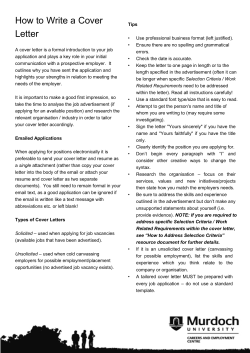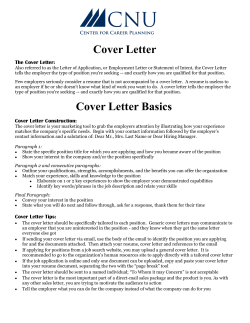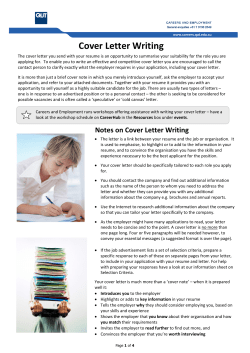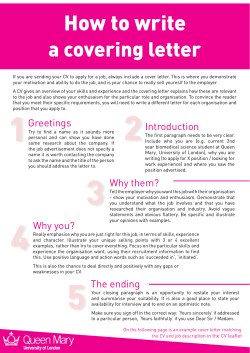
Cover letters (letters of application) Cover letters (also known as
Cover letters (letters of application) Cover letters (also known as Letters of Application) are generally used in two job search situations: when applying for an advertised vacancy and when making a direct approach to an employer. Advertised vacancies When applying for advertised or known vacancies, a cover letter should be written specifically for each position for which you are applying. Never send a cover letter that reads like a circular which is being sent to every employer on a list. In the cover letter, you seek to persuade the employer that you are a suitable candidate for the job, by illustrating you have the key skills, experience and personality traits outlined in the job description or at the recruitment presentation. A well written cover letter will interest the employer in reading your CV to learn more about you. Direct approach to an employer When making an unsolicited application, it is important that each cover letter is written specifically for the organisation you are approaching. Researching the organisation (via websites, through your network of contacts or other resources) is critical to producing a wellfocused sales pitch. Through your research, identify what skills, experience and personality traits are or might be of interest to the employer you are approaching, and make sure you have highlighted these in both your cover letter and your CV. See the section on the Direct Approach on page 13 in this guide. 18 Are you ready to write your cover letter? • Do you know who to address the letter to? If not – find out, where possible. • Have you thought about why you want this job and to work for this organisation? Be specific. • Are you clear on the top 5 or 6 key competencies/ skills, experience and/ or personal attributes the employer is looking for and how you can demonstrate a match between you and the position? • Have you decided what makes you different or unique? What makes you stand out from other applicants? What are your ‘points of difference’? • Think about how you can interest the employer in what you have to say – what are your ‘headlines’ to hook them in and interest them in reading your CV? Formatting guidelines • Avoid coloured or lined paper. • Use black ink and avoid block capitals. • Type your cover letter – unless the employer has specifically requested it to be handwritten. • Use no more than one A4 page (even if you’re sending the letter as an email – the employer will probably print it out). • For an effective layout, use appropriate spacing and margins, and try to balance your letter in the centre (top to bottom) of the page. • Choose whether using bullet points and/or paragraphs will be the most effective way for you to write your cover letter. • Keep your sentences short and clear. Content guidelines • If you know the name of the person to whom you are sending the cover letter, use their title and name in the salutation (e.g. ‘Dear Ms Smith’). Sign your letter ‘Yours sincerely’. If their name does not clearly identify their gender, write their full name (e.g. ‘Dear Pat Smith’) and sign your letter ‘Yours sincerely’. If you do not know the name of the person you are writing the letter to, use ‘Dear Sir / Madam’ and sign your letter ‘Yours faithfully’. • Interpret the organisation’s website and literature to demonstrate you understand their needs and how the information applies to you and the job. • Remember when writing a paragraph that it usually consists of 3–5 sentences and the first sentence of each paragraph needs to introduce what that paragraph is about. • Make sure you use examples to illustrate what you have to offer. • Avoid repetition of ideas, words and phrases in sentences. Use a thesaurus or the list of action verbs on page 29. Try to use a variety of sentence structures – don’t start every sentence with ‘I’. • Un-paragraph or un-bullet point the information (temporarily) and look at each sentence you have written. Put each sentence on its own line. Does each sentence make sense individually? • Check each sentence to ensure your grammar, spelling and punctuation are correct. • Re-paragraph your letter, ensuring that your points are being presented in a logical and structured manner within each paragraph and within the overall cover letter. Address Your contact telephone number Your cover letter is the first thing an employer will read – what impression does it give about you? 2 spaces 5 January 2013 2 spaces Employer’s name Their position Company/organisation name Postal address including post code City (and country if sending internationally) 2 spaces Dear Mr/Ms./Mrs Employer’s Last Name Re: Vacancy position and reference number An Introduction State clearly why you are writing to them (including the department or location preferred, if appropriate) and mention that your curriculum vitae is enclosed. Say where and when you saw the position advertised. Use bullet points instead of paragraphs if you think it will get your points across more clearly and effectively. What I can offer you Research the organisation and the position to identify what they are looking for. Write two or three paragraphs drawing attention to those aspects of your qualifications, experience, skills, personal attributes, achievements and interests which show how you match the requirements of the job and the organisation. Illustrate by using examples. Refer to your CV where appropriate. Why does this organization appeal? Describe your reasons for applying for this job - what is your motivation to apply to work for this particular organisation, in this particular role. Be specific – why them? The Conclusion Restate your interest in the position and that you look forward to hearing back from them. Thank them for taking the time to consider your approach or application. 2 spaces Yours sincerely 5 spaces (approximately) If you are making an unsolicited approach, mention that you will contact them by a certain date to follow up this letter. If you would like to speak to them about future opportunities in their industry sector overall, clearly request this. This may create a networking opportunity for you to find out more about other jobs. Signature Your name 19
© Copyright 2025





















